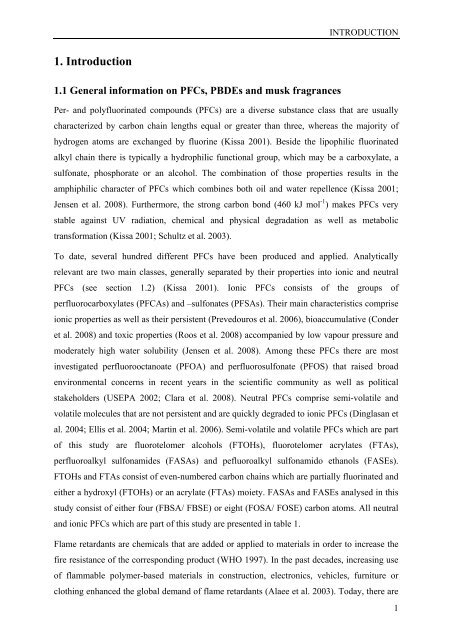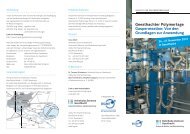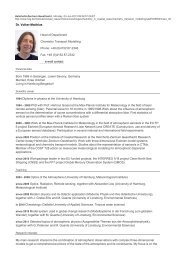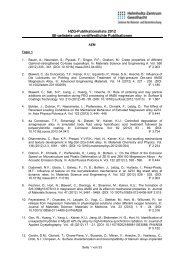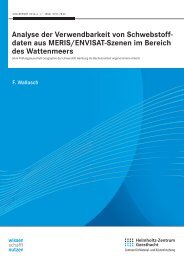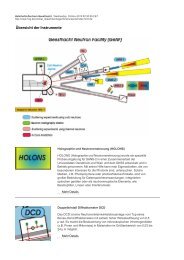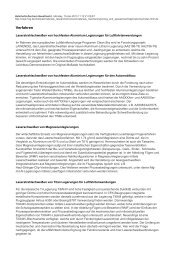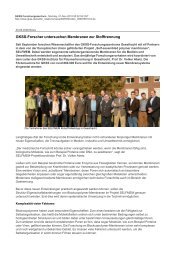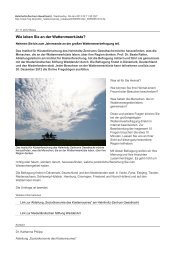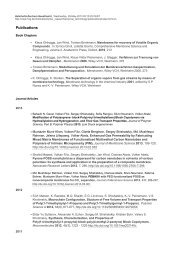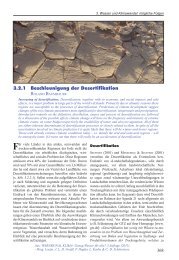Landfills and waste water treatment plants as sources of ... - GKSS
Landfills and waste water treatment plants as sources of ... - GKSS
Landfills and waste water treatment plants as sources of ... - GKSS
You also want an ePaper? Increase the reach of your titles
YUMPU automatically turns print PDFs into web optimized ePapers that Google loves.
1. Introduction<br />
1.1 General information on PFCs, PBDEs <strong>and</strong> musk fragrances<br />
INTRODUCTION<br />
Per- <strong>and</strong> polyfluorinated compounds (PFCs) are a diverse substance cl<strong>as</strong>s that are usually<br />
characterized by carbon chain lengths equal or greater than three, where<strong>as</strong> the majority <strong>of</strong><br />
hydrogen atoms are exchanged by fluorine (Kissa 2001). Beside the lipophilic fluorinated<br />
alkyl chain there is typically a hydrophilic functional group, which may be a carboxylate, a<br />
sulfonate, phosphorate or an alcohol. The combination <strong>of</strong> those properties results in the<br />
amphiphilic character <strong>of</strong> PFCs which combines both oil <strong>and</strong> <strong>water</strong> repellence (Kissa 2001;<br />
Jensen et al. 2008). Furthermore, the strong carbon bond (460 kJ mol -1 ) makes PFCs very<br />
stable against UV radiation, chemical <strong>and</strong> physical degradation <strong>as</strong> well <strong>as</strong> metabolic<br />
transformation (Kissa 2001; Schultz et al. 2003).<br />
To date, several hundred different PFCs have been produced <strong>and</strong> applied. Analytically<br />
relevant are two main cl<strong>as</strong>ses, generally separated by their properties into ionic <strong>and</strong> neutral<br />
PFCs (see section 1.2) (Kissa 2001). Ionic PFCs consists <strong>of</strong> the groups <strong>of</strong><br />
perfluorocarboxylates (PFCAs) <strong>and</strong> –sulfonates (PFSAs). Their main characteristics comprise<br />
ionic properties <strong>as</strong> well <strong>as</strong> their persistent (Prevedouros et al. 2006), bioaccumulative (Conder<br />
et al. 2008) <strong>and</strong> toxic properties (Roos et al. 2008) accompanied by low vapour pressure <strong>and</strong><br />
moderately high <strong>water</strong> solubility (Jensen et al. 2008). Among these PFCs there are most<br />
investigated perfluorooctanoate (PFOA) <strong>and</strong> perfluorosulfonate (PFOS) that raised broad<br />
environmental concerns in recent years in the scientific community <strong>as</strong> well <strong>as</strong> political<br />
stakeholders (USEPA 2002; Clara et al. 2008). Neutral PFCs comprise semi-volatile <strong>and</strong><br />
volatile molecules that are not persistent <strong>and</strong> are quickly degraded to ionic PFCs (Dingl<strong>as</strong>an et<br />
al. 2004; Ellis et al. 2004; Martin et al. 2006). Semi-volatile <strong>and</strong> volatile PFCs which are part<br />
<strong>of</strong> this study are fluorotelomer alcohols (FTOHs), fluorotelomer acrylates (FTAs),<br />
perfluoroalkyl sulfonamides (FASAs) <strong>and</strong> pefluoroalkyl sulfonamido ethanols (FASEs).<br />
FTOHs <strong>and</strong> FTAs consist <strong>of</strong> even-numbered carbon chains which are partially fluorinated <strong>and</strong><br />
either a hydroxyl (FTOHs) or an acrylate (FTAs) moiety. FASAs <strong>and</strong> FASEs analysed in this<br />
study consist <strong>of</strong> either four (FBSA/ FBSE) or eight (FOSA/ FOSE) carbon atoms. All neutral<br />
<strong>and</strong> ionic PFCs which are part <strong>of</strong> this study are presented in table 1.<br />
Flame retardants are chemicals that are added or applied to materials in order to incre<strong>as</strong>e the<br />
fire resistance <strong>of</strong> the corresponding product (WHO 1997). In the p<strong>as</strong>t decades, incre<strong>as</strong>ing use<br />
<strong>of</strong> flammable polymer-b<strong>as</strong>ed materials in construction, electronics, vehicles, furniture or<br />
clothing enhanced the global dem<strong>and</strong> <strong>of</strong> flame retardants (Alaee et al. 2003). Today, there are<br />
1


